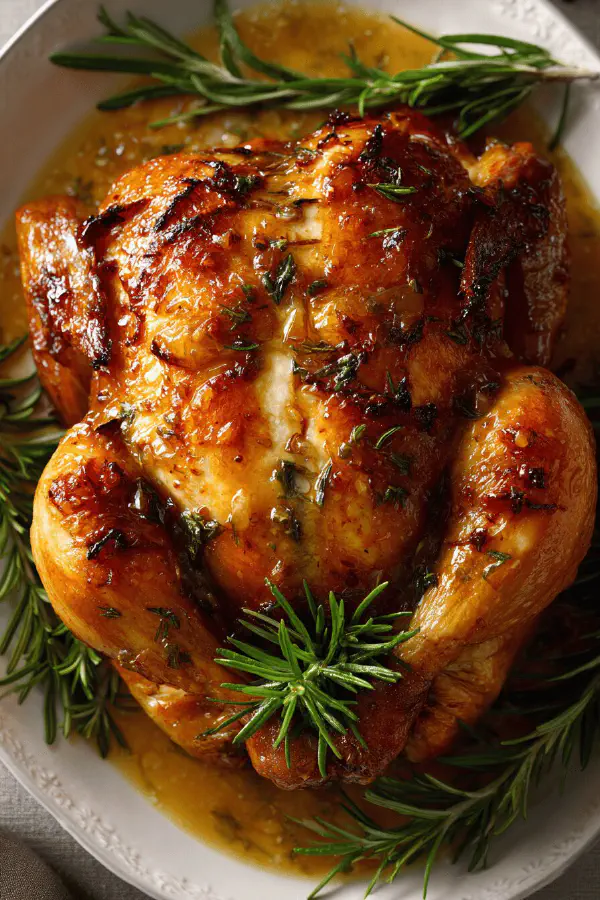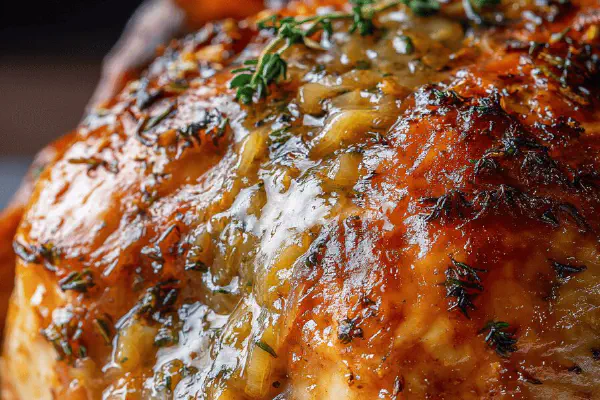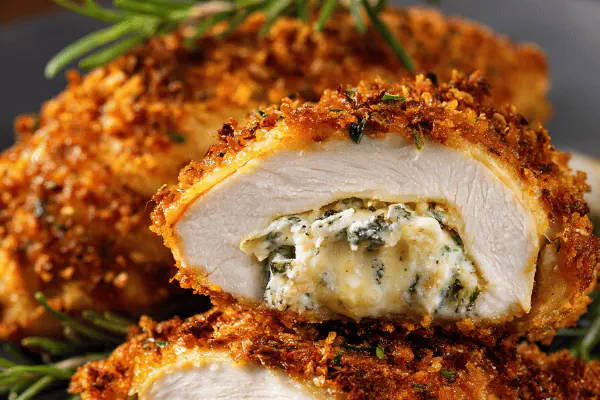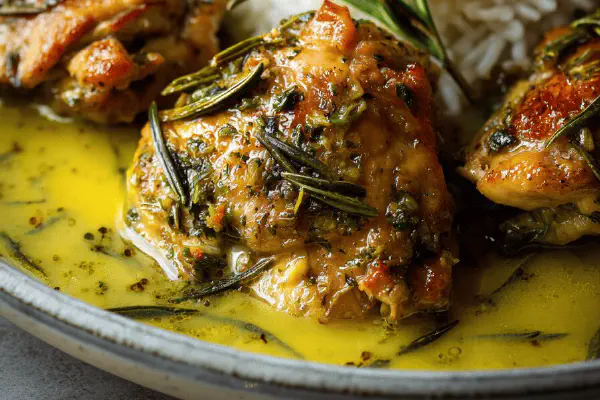Featured Recipe
Roast Chicken with Apricot Glaze

By Kate
"
Whole chicken slathered with a butter, apricot jam, and fresh herbs paste tucked beneath the skin. Roast until golden, juices run clear, internal temp 80-85 °C. Pan drippings saved to boost a bright rosemary-orange sauce thickened with cornstarch. A twist on classic marmalade mustard glaze; swap apricot jam for marmalade or peach preserves, rosemary for thyme. Butter swap possible with ghee or olive oil for dairy-free. Cooking cues focus on skin crispness and thigh temperature, not blindly on time.
"
Prep:
25 min
Cook:
Total:
Serves:
5 servings
chicken
main dish
roasting
French cuisine
Introduction
Start with a whole bird, fresh and plump. Not your average roast. The apricot jam swapped for marmalade; rosemary steps in for parsley to bring piney lift instead of grassy. Butter replaced with ghee—dairy-free or just richer flavor. Mustard grainy, not Dijon—gritty tang under the skin. The real trick? Cut out backbone, flatten bird flat on tray, crisp skin from every angle. Watch that temperature, 80 °C in thigh, juices running clear, not pink. Baste with pan juices to keep edges glossy. For sauce, forget plain gravy—thickened orange juice with drippings, bright and velvety, proper sauce with body. Layers of flavor working not spit-shined but earned. Keep it simple, cook it right.
Ingredients
About the ingredients
Jam swap: apricot preferred for smooth sweetness, marmalade offers citrus punch; peach preserves too but less acid. Butter replaced with ghee or olive oil for dairy-free or different mouthfeel—ghee browns better, olive oil lighter. Instead of parsley, rosemary offers firmer, aromatic needle-like leaves; fresh essential, dried can double amount but less fragrant. Grainy mustard holds texture, adds spice. Whole chicken weight affects timing; under 1.8 kg, reduce roasting by 10–15 mins. Pan juices vital for sauce; don’t discard. Orange juice fresh; bottled compromises brightness. Chicken stock can be veggie for twist but less deep flavor. Cornstarch swaps for flour for clarity in sauce, no cloudiness.
Method
Roast chicken
- Set oven rack in middle position. Preheat oven to 200 °C (390 °F). Line a rimmed baking sheet with parchment paper or foil for easy cleanup.
- In a mixing bowl, blend apricot jam, ghee, rosemary and grainy mustard well. Season with salt and pepper. This paste will sit under skin; push gently.
- Using a sharp chef's knife or kitchen shears, cut along each side of the backbone and remove it to allow the bird to lay flat — spatchcock style. Saves time, crisper skin all around.
- Carefully, starting at the breast and thighs, separate the skin from the meat using fingers. Don’t tear; work slowly. Spread half the paste beneath skin evenly, massage into breast and thighs. Rub rest on skin and cavity. Salt and pepper again outside.
- Place chicken skin side up on the prepared sheet. Roast in hot oven for about 1 hour 15 minutes, checking at 50 minutes. Skin should turn golden brown and jitter slightly when nudged. Internal temp at thickest thigh: 80-85 °C (175-185 °F). Use instant-read thermometer, avoid touching bone for accurate reading.
- Halfway through cooking, baste chicken with pan juices. If juices evaporate too fast, add a splash of water or stock to keep moist.
- Remove when done, tent loosely with foil, rest 15 minutes. Resting lets juices redistribute; slice too soon and you’ll lose them.
- While chicken rests, carefully pour pan drippings into small saucepan, leave any burned bits behind on sheet.
- Heat ghee or olive oil over medium flame, sprinkle cornstarch, whisk constantly for 1-2 minutes until lightly toasted and bubbly — this forms roux-like base for sauce thickening.
- Gradually whisk in orange juice and broth. Bring to gentle boil, stir continuously until sauce thickens and shines, about 3 minutes.
- Add reserved pan juices to sauce. Adjust salt and pepper. Taste for balance — bright, savory, herbaceous.
- Serve sauce warm alongside chicken. Good with roasted vegetables or crispy potatoes.
- Apricot jam adds mild sweetness and smoothness; Swap marmalade for tang or replace rosemary with thyme or oregano for another herbal angle. If butter or ghee isn’t available, use olive oil but flavor depth varies.
- Spatchcocking shaves off up to 20 minutes roasting time, plus guarantees an even cook. Don’t rush skin separation; small tears create greasy patches instead of crispy skin.
- Skip the glaze under skin? Slather on top only but you’ll sacrifice moisture locked into the meat.
- Thermometer crucial. Wing or thickest thigh bone temp can mislead. Insert probe sideways trimming fat if bird jiggles too much while testing.
- Basting — optional but worthwhile. Adds to skin color and flavors chicken from outside in.
- Rest chicken uncovered if your kitchen isn’t dry; uncovered skin stays crisp. Tent loosely if air is dry outside of oven to avoid drying meat.
- Sauce thickening with cornstarch preferred over flour for sheen and no pasty taste — whisk constantly to avoid lumps.
- No fresh rosemary? Use 2 ml (1/2 tsp) dried crushed but store-bought tends to lack punch. Adding grated orange zest to sauce grants extra aroma.
- Make ahead sauce can be kept warm gently or reheated with splash of broth. Chicken benefits from resting even 20 minutes.
- Visual cues key: golden brown, skin pulled tight, juices clear if poked at thickest meat. When in doubt, probe deeper or wait a few minutes to avoid undercooked risk.
Rosemary orange sauce
Tips & tweaks
Technique Tips
Spatchcocking key for even heat exposure and fast cooking. If uncomfortable with removing backbone, use kitchen shears or ask butcher. Skin separation crucial—takes patience, avoid tearing; less tearing means less drying risk and better render of fat. Spread butter-herb paste evenly and under skin to flavor close to meat. Salt chicken adequately but consider low-sodium if stock or jam salty. Roast skin side up; mid-oven rack provides even radiant heat—too high burns, too low uneven color. Basting mid-cook keeps skin moist but skip if in hurry. Check internal temp early—if above 85 °C, risk dryness; under 80 °C, keep cooking but check again quickly to avoid overdone chicken. Resting moist, juicy finish; loosely tent. Sauce: careful whisking critical to avoid lumps in cornstarch roux; continual bubbling signals proper thickening. Adding pan juices last lifts depth—don’t discard drippings despite bits—strain if worried about burnt flavor.
Chef's Notes
- 💡 Patience matters. Skin separation needs slow work, avoid tears. Tight skin, crisp later. Don't rush or you’ll end up greasy.
- 💡 Basting optional, but it can add color. Sauce touch can bring depth, keep skin moist but in a hurry, skip it.
- 💡 Check internal temp early. Thigh should hit 80-85 °C. Bone touching can mislead. Aim for clear juices too.
- 💡 Rest post-roast for 15 minutes. Locks in juices; cut too soon, you lose flavor. Air exposure= crispy skin.
- 💡 Substitution work: ghee or olive oil; if dairy-free. Marmalade can replace jam, but flavor shifts. Experiment.
Kitchen Wisdom
Cooking time too long?
Check temp sooner. Fix fast, avoid dryness. Err on pulling out too early.
Chicken too dry?
Maybe overcooked. Ensure even temp checks. Use a probe, avoid bone.
How to store leftovers?
Cool first; airtight container needed. Fridge up to 3 days, freeze longer.
Lumpy sauce fix?
Reheat gently and whisk hard. Blend if needed. Strain for clarity, avoid pasty.



